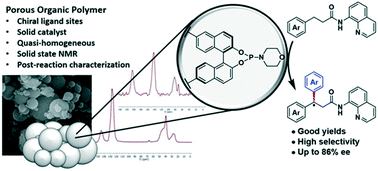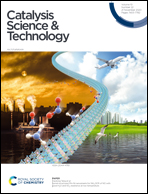A chiral porous organic polymer as a heterogeneous ligand for enantioselective Pd-catalyzed C(sp3)–H functionalization†
Abstract
Catalytic enantioselective C(sp3)–H functionalization remains a difficult task, even more so using heterogeneous catalysts. Here, we report the first example of enantioselective C(sp3)–H functionalization using a chiral porous organic polymer as the heterogeneous catalyst. The catalyst consists of a polystyrene-incorporating chiral phosphoramidite coordinated to palladium, and it provides up to 86% ee for the challenging enantioselective C(sp3)–H functionalization of a range of 3-arylpropanamides. The swelling properties of the catalyst allow for quasi-homogeneous behavior in the reaction mixture while still enabling easy catalyst separation from the reaction medium and reuse. Thorough characterization of the fresh porous organic polymer and recycled catalyst material by 31P CP/MAS NMR, 13C–1H CP/MAS NMR, X-ray diffraction, TEM, STEM, EDX–SEM, ICP, and XRF in combination with modifications to the reaction conditions for the recycled catalyst material reveals potential explanations for catalyst deactivation.



 Please wait while we load your content...
Please wait while we load your content...